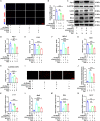REPIN1 regulates iron metabolism and osteoblast apoptosis in osteoporosis
- PMID: 37749079
- PMCID: PMC10519990
- DOI: 10.1038/s41419-023-06160-w
REPIN1 regulates iron metabolism and osteoblast apoptosis in osteoporosis
Abstract
Osteoporosis is not well treated due to the difficulty of finding commonalities between the various types of it. Iron homeostasis is a vital component in supporting biochemical functions, and iron overload is recognized as a common risk factor for osteoporosis. In this research, we found that there is indeed evidence of iron accumulation in the bone tissue of patients with osteoporosis and REPIN1, as an origin specific DNA binding protein, may play a key role in this process. We revealed that sh-Repin1 therapy can rescue bone loss in an iron-overload-induced osteoporosis mouse model. Knockdown of Repin1 can inhibit apoptosis and enhance the resistance of osteoblasts to iron overload toxicity. REPIN1 promoted apoptosis by regulating iron metabolism in osteoblasts. Mechanistically, knockdown of Repin1 decreased the expression of Lcn2, which ameliorated the toxic effects of intracellular iron overload. The anti-iron effect of lentivirus sh-Repin1 was partially reversed or replicated by changing LCN2 expression level via si-RNA or plasmid, which indirectly verified the key regulatory role of LCN2 as a downstream target. Furthermore, the levels of BCL2 and BAX, which play a key role in the mitochondrial apoptosis pathway, were affected. In summary, based on the results of clinical specimens, animal models and in vitro experiments, for the first time, we proved the key role of REPIN1 in iron metabolism-related osteoporosis.
© 2023. The Author(s).
Conflict of interest statement
The authors declare no competing interests.
Figures







Similar articles
-
Regulation of DMT1 on autophagy and apoptosis in osteoblast.Int J Med Sci. 2017 Feb 24;14(3):275-283. doi: 10.7150/ijms.17860. eCollection 2017. Int J Med Sci. 2017. PMID: 28367088 Free PMC article.
-
Iron overload-induced ferroptosis of osteoblasts inhibits osteogenesis and promotes osteoporosis: An in vitro and in vivo study.IUBMB Life. 2022 Nov;74(11):1052-1069. doi: 10.1002/iub.2656. Epub 2022 Jun 11. IUBMB Life. 2022. PMID: 35638167
-
Iron overload induced death of osteoblasts in vitro: involvement of the mitochondrial apoptotic pathway.PeerJ. 2016 Nov 8;4:e2611. doi: 10.7717/peerj.2611. eCollection 2016. PeerJ. 2016. PMID: 27843711 Free PMC article.
-
The Effect of Abnormal Iron Metabolism on Osteoporosis.Biol Trace Elem Res. 2020 Jun;195(2):353-365. doi: 10.1007/s12011-019-01867-4. Epub 2019 Aug 31. Biol Trace Elem Res. 2020. PMID: 31473898 Review.
-
Replication initiator 1 in adipose tissue function and human obesity.Vitam Horm. 2013;91:97-105. doi: 10.1016/B978-0-12-407766-9.00005-5. Vitam Horm. 2013. PMID: 23374714 Review.
Cited by
-
Research on the role and mechanism of the PI3K/Akt/mTOR signalling pathway in osteoporosis.Front Endocrinol (Lausanne). 2025 May 12;16:1541714. doi: 10.3389/fendo.2025.1541714. eCollection 2025. Front Endocrinol (Lausanne). 2025. PMID: 40421249 Free PMC article. Review.
-
M1 macrophage-derived exosomes promote intervertebral disc degeneration by enhancing nucleus pulposus cell senescence through LCN2/NF-κB signaling axis.J Nanobiotechnology. 2024 May 31;22(1):301. doi: 10.1186/s12951-024-02556-8. J Nanobiotechnology. 2024. PMID: 38816771 Free PMC article.
-
Lipocalin-2 and intestinal diseases.World J Gastroenterol. 2024 Dec 14;30(46):4864-4879. doi: 10.3748/wjg.v30.i46.4864. World J Gastroenterol. 2024. PMID: 39679305 Free PMC article. Review.
-
Arctiin alleviates knee osteoarthritis by suppressing chondrocyte oxidative stress induced by accumulated iron via AKT/NRF2/HO-1 signaling pathway.Sci Rep. 2024 Dec 30;14(1):31935. doi: 10.1038/s41598-024-83383-7. Sci Rep. 2024. PMID: 39738432 Free PMC article.
-
Metal ion metabolism and osteoporosis: possible implications for pharmaceutical biotechnology and tissue engineering.Sci China Life Sci. 2024 Aug;67(8):1763-1765. doi: 10.1007/s11427-023-2541-x. Epub 2024 Apr 25. Sci China Life Sci. 2024. PMID: 38676813 No abstract available.
References
Publication types
MeSH terms
Substances
LinkOut - more resources
Full Text Sources
Medical
Molecular Biology Databases
Research Materials
Miscellaneous

